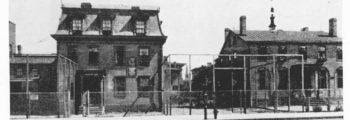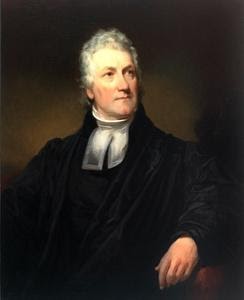|
Dear St. PJ’s friends, This week I am wrapping up my little three-part series that glimpses some of St. PJ’s long and rich history. One of the things we’re most proud of here at St. PJ’s is our longstanding commitment to helping our neighbors, so today’s letter focuses on PJ’s history of mission and outreach throughout the years. Mission: In the 1850s, the Episcopal Church was flourishing in New Haven, and St. Paul’s was the second of eight churches to be formed within 50 years. Two of the others, St. John’s and Church of the Ascension (which no longer exists) were formed from Missions of St. Paul’s. The church also became involved in mission work beyond Connecticut, paying for the first Episcopal missionary in Kansas. This missionary, Rev. Hiram Stone, founded one of the earliest Episcopal churches in Leavenworth, KS, in 1856, and named it St. Paul’s after St. Paul’s, New Haven. Throughout all of St. Paul’s history, it prided itself on its Sunday School, which in 1904 comprised of 500 students, 50 teachers, and 6 librarians for the library. Since the public library did not exist before 1905, a tradition was started of giving a book to every Sunday School student each Easter. Around 1904, a Chinese Sunday School was opened for about 20 students, and a book with hymns and prayers was translated into Chinese for them. Outreach: Beyond spreading the Word of God in the traditional sense of the word “mission,” St. Paul’s has had a history of spreading care in the forms of fellowship, food, clothes, books, and more to vulnerable populations. As early as the 1850s and 60s, the Sunday School Teacher’s Society was created to help children in need, among other work. In 1861, the Society distributed 2535 garments to those in need, particularly children. In the late 1890s, Betsy Bradley, a loyal parishoner, left two thirds of her estate to St. Paul’s, designating half of that to be used to establish the St. Paul’s Church Home for Aged Women. The Church Home housed 10-12 occupants plus a matron and a nurse, and existed until it closed 1995. At that point the Betsy Bradley Trust Fund was redesignated as a staff position called the Minister of Spirituality and Aging, continuing the parish’s ministry of working with older people. In response to the wave of Italian immigration in the early 20th century, and keeping in St. Paul’s spirit of mission, the parish established the Neighborhood House, a settlement house which provided classes for Italian children, Italian men, and Chinese men, and included a bank and a library. One component, the Neighborhood Music School, became its own entity and continues today. In the early 1980s, Loaves and Fishes was launched, started by our very own Hanne Howard who began stockpiling non-perishable food in the church office for neighbors who asked for it. Today, Loaves and Fishes is its own non-profit organization, providing food and clothing to neighbors in need. Keep an eye out for weekly updates in the Grace Notes section of the bulletin! In the 1990s, St. PJ’s ran a Children’s Mission, which included an after-school program, a Saturday morning reading program, and Tuesday night Compline and a meal for local children, echoing St. Paul’s mission from over 100 years prior to support and nourish children, literally, spiritually, and intellectually. Community support: While St. PJ’s has started and nurtured many endeavors led by the parish, we also have supported a large variety of community and non-profit organizations by providing financial and political help, space in our building, and meaningful partnership. This has been especially true in more recent history. Here are just a few examples of our presence in the neighborhood: In the 1960s/70s, St. Paul’s gave financial and political support for the “Friendship Apartments” affordable housing development between Artizan and Olive streets. The Yale AIDS Program in the late 80s and 90s used the basement as their headquarters. IRIS (Integrated Refugee and Immigrant Services) used the basement space from when they arrived in New Haven 1995 until 2006 when they moved to their current location in East Rock (fun fact: IRIS grew out of an initiative by the Episcopal Diocese of Connecticut to welcome and resettle Southeast Asian refugees fleeing communist regimes after the Vietnam War). Our undercroft currently houses Sunrise Café (since 2016), which serves free breakfast every weekday morning and was co-founded by Anne Calabresi, and City Seed Inc.’s Sanctuary Kitchen (since 2019), as well as a variety of 12-step recovery groups. These are only a few of the many activities and outreach that St. PJ’s has been involved with over its long history! St. PJ’s has long been a neighborhood cornerstone, and I can’t wait to see where the next years take us as we explore what it means to serve the community in new ways. We have a beautiful building, a historic legacy, and a forward-looking faith.
Let’s continue to love, grow, serve and go, rejoicing in the power of the spirit! Peace, Claire
1 Comment
Dear St. PJ’s friends, To continue sharing some of what I have learned while researching PJ’s history, here are a few bits and pieces of history that focus less on the building and the architecture, and more on the people who made up this congregation over the years, and the cultural context of the neighborhood and beyond. Cultural significance: During the early 19th century, thanks to the Second Great Awakening and the dynamism of their rector, Rev. Dr. Harry Croswell, the parish of Trinity Church in New Haven expanded rapidly. To accommodate growing numbers, they decided to build a “chapel of ease” in a new, outlying residential district, Wooster Square. For 15 years (1830-1845) St. Paul’s was a chapel of Trinity, before breaking away and becoming its own independent parish. A bit about Harry Croswell: He was a New York journalist involved in the famed Supreme Court case People vs. Croswell (his lawyer for the case was Alexander Hamilton!), which was key in protecting the freedom of the press and establishing libel laws. He left politics and journalism to join the church, becoming the rector of Trinity Church, New Haven. During his tenure the Episcopal church grew from one to eight churches in New Haven, of which St. Paul’s was the first after Trinity. He is also famous for being the first to publish the definition of the word “cocktail” during his time as a journalist: Cock-tail, then, is a stimulating liquor, composed of spirits of any kind, sugar, water, and bitters; it is vulgarly called bittered sling, and is supposed to be an excellent electioneering potion, in as much as it renders the heart stout and bold, at the same time that it fuddles the head. It is said also to be of great use to a democratic candidate: because a person having swallowed a glass of it, is ready to swallow anything else. In 1851, gas lighting was installed at St. Paul’s. Around this time, most of the parish income was from pew rentals, since men would pay large sums for their pews, as they were a symbol of status and “gentility.” Wooster Square was made up primarily of wealthy entrepreneurs and ship captains a the time. Around 1879, the population of the church began shifting from wealthy aristocratic families to a city church full of people from all classes and localities. During a time when many churches were moving to “better neighborhoods,” St. Paul’s was proud to stay where they were and adapt to shifting populations in the city. In 1911, Wooster Square became the hub for an influx of Italian immigration, whose legacy lives on through several renowned pizzerias that can still be found on Wooster Street. St. Paul’s once again considered moving, but decided not to leave their beautiful building, and in fact became the last remaining of four Protestant churches in the area. There was some effort put in to attracting the Italians, including having a service in Italian, but it was not very successful because the Italians were “too Catholic.”
During the period of World War I, particularly in 1918, church was in a bit of a decline generally, with energy and money diverted to the war effort. The rector at the time, George Paine, left for the front in 1918, giving his resignation. According to records of a Recognition service in June, 1918, 84 stars were placed on a service flag for parish members who served in the war. Most of these served in the Twenty-Sixth Division, and none of them died. The 1920s brought about several key changes in the church. On January 24, 1924, two women were elected to the Vestry, the first two women to hold the position in the Diocese of Connecticut. Since then, women have always served on St. Paul’s vestry. Then in 1926, a free pew system was put in operation, to “bring the right atmosphere into the Church of Christ.” In 1941, the U.S. entered World War II, and many young people went off to war. The service flag at St. Paul’s included stars for 165 young men and women serving. The Wednesday morning church service became a service dedicated to praying for them. Since gasoline was rationed, church and Sunday School attendance dropped off, as many families could no longer make it to church. During the 1950s, Wooster Square gained national renown for preservation and urban renewal efforts, and the neighborhood was designated a National Historic District in 1971. St. Paul’s rectory and St. Paul’s Church Home for Women were two properties that greatly exhibited the historic architecture of the district. St. PJ's has always been at the forefront of progressive development, electing the first women to the Vestry in the Diocese of Connecticut, and being an early church to integrate racially. This legacy of neighborhood engagement and inclusion is encompassed beautifully in the mural by Julie Dickerson in our basement entitled "Dance with the Saints" (2010), featuring important local figures dancing with saints throughout history. These include a New Haven Ballet dancer, the founder of AA, a capoeira dancer, Martin Luther King, Jr., among others. Hopefully these glimpses of the people and the neighborhood through the years helps connect us to those who came before. Much of this history is summarized, lost, or missing, and we can only imagine what these people were really like, their hopes and dreams and faith, yet we can feel their legacy and presence in our church. That being said, this history I’m compiling is a work in progress, and if anyone has any information or stories they would like to add, particularly in our more recent history, please feel free to email ([email protected]) or call me (847-624-5685)! Stay tuned next week for more information on St. PJ’s history of mission and outreach throughout the years! Peace, Claire |
AuthorClaire Cody ArchivesCategories |
Directions
|
Weekly Services
|







 RSS Feed
RSS Feed